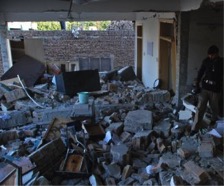
Reinforced concrete is really a wonderful thing (the same goes for reinforced concrete masonry unit (CMU) block walls). We take two completely different types of materials (concrete and steel) and combine them to take advantage of the best of both materials. Concrete (and CMU) elements are strong in compression – like when gravity presses down along the vertical axis of a wall or column – but if you try to pull it apart or bend it, it tends to fracture. Steel could be strong in compression if you had enough cross-sectional area, but where it really shines is in tension, as when you pull it. Steel is strong in tension and can bend without breaking. Think of concrete like a pencil (if you bend a pencil hard enough, it will break) and the steel like a paperclip (you can bend it back and forth quite a few times before it breaks). The pencil is exhibiting brittle behavior and the paperclip is exhibiting ductile behavior.
So, the beauty of reinforced concrete, or reinforced CMU block walls, is that the steel (rebar) and concrete or CMU are combined so that they are strong in compression (from the concrete/CMU) but they can also bend (to a point) without breaking. You might ask yourself, when do we bend a beam, or a wall or a column. Well, there are lots of answers, but the one that we are concerned with is, Explosive Events or Blasts.
An explosion is a rapid release of energy in the form of light, heat, sound and a shock wave, and it is the shock wave that we look at most often in blast resistant design (or when determining the strength of an existing building to a blast). The shock wave does not generally apply forces in the same direction as gravity, rather it applies the load at 90 degrees to the direction of gravity (in the case of columns and walls) or opposite the direction of gravity (in the case of uplift on slabs and beams). Since reinforced concrete and reinforced CMU walls have the ability to bend, they can be designed to resist blast loads or (in the case of existing buildings) they will be able to resist more blast load than an unreinforced element.
The first photo below shows the failure of unreinforced walls from explosive forces. Note that the columns and beams that are around the walls faired much better than the walls themselves. This is because they were constructed of reinforced concrete. This next photo shows the same type of failure from the interior or occupied space within the building. The failure of the exterior, unreinforced, wall is catastrophic (that is, it didn’t just bend in and end up curved or out-of-plumb, it blew right into the room). Injuries from this type of failure can be significant and widespread. The second photo shows the same type of failure from the interior or occupied space within the building. The failure of the exterior, unreinforced, wall is catastrophic (that is, it didn’t just bend in and end up curved or out-of-plumb, it blew right into the room). Injuries from this type of failure can be significant and widespread.
All of the above is an attempt to explain why any building, wall, or structure that is supposed to be designed to resist explosions or is being built in a region of the world where there is a threat of explosion (Afghanistan, Yemen, Iraq, Somalia, Nigeria, to name just a very few) should NEVER be built with unreinforced walls.


